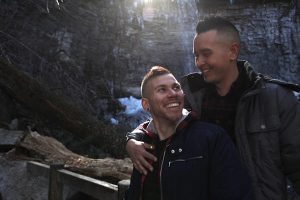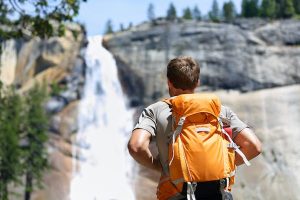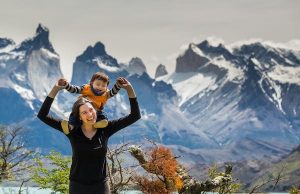
Yellowstone is the world’s oldest national park, and its more than 3400 square miles are full of incredible wildlife viewing, powerful geysers and other geothermal features, and beautiful scenery. Each season provides a different visitor experience, so considering the time of year is imperative when planning your visit.
The park’s busiest season is late May through September. Most of the park’s roads are closed to cars from late fall through spring, with most gradually reopening in late April and May, though during inclement weather any road can close. Services are very limited outside of peak season – keep the weather in mind as you plan, and be prepared for changing conditions at any time of year, from snow or thunderstorms in summer to winter’s fierce blizzards and subzero temperatures.
Get trusted guidance to the world’s most breathtaking experiences delivered to your inbox weekly with our email newsletter.
It’s worth taking the time to learn about wildlife safety to prepare you for any wildlife you might encounter, from bison to bears. Keep a safe distance (minimum distance from bears and wolves is 100 yards, with a minimum of 25 yards for other species), and read up on bear safety as well as the park’s other safety tips, including other wildlife, geothermal features, and environmental and driving conditions.
Entrance to the park costs $35 for a private vehicle for seven days, though a variety of other types of passes are also available, including annual passes. Camping fees and some hiking permits are an additional cost. Here’s how to time your next trip to Yellowstone National Park.
June to August is the best time for camping
Most of Yellowstone’s campgrounds open in May or June and close in early fall, so summer is prime time if you want to sleep under the stars. Reserve sites as early as possible if you have your heart set on camping. Pitch a tent, go for hikes, explore the park’s hydrothermal areas (be sure to see the famous Old Faithful geyser), observe wildlife, cook meals together, and make memories for a lifetime. If you prefer backcountry camping, consider a detour off the beaten track.
While summer is the park’s busiest season, the crowds are there for a reason. Weather and construction permitting, all the park’s roads are generally open and Yellowstone is at its most accessible. In summer daytime temperatures are often 70-80°F, though some areas can drop below freezing at night, so be sure to bring what you need to stay cozy and warm. Summer thunderstorms are common, and snow is possible. When camping in bear country, it’s imperative you keep a clean camp and lock all food away securely.
 Fall is the perfect time for budding photographers to capture Yellowstone’s beauty © Getty Images
Fall is the perfect time for budding photographers to capture Yellowstone’s beauty © Getty Images
September and October are best for fall photography
While every season in Yellowstone is a photographer’s dream, fall provides opportunities to capture images of wildlife amidst the beautiful fall foliage.
September and October also usher in the elk rut where males bugle and clash with other males to compete for mating opportunities. It can be seen near Mammoth Hot Springs and Grant Village, but be sure to bring your telephoto lenses, stay at least 25 yards away, never approach them, and always be vigilant – elk have seriously injured visitors who got too close in the past.
Fall can be quite busy, especially September, so expect to have company. The crowds wane significantly in October and are generally gone by November (most of the park’s roads close in early November). Many park services close in late September and early October, so be prepared. Daytime highs are often 30-60F, though evenings can be quite cold and snow is possible.
November to March is best for avoiding crowds
Winter is the park’s slow season, with just a fraction of the visitors seen in the summer. For example, in July 2021, Yellowstone reported over 1 million recreational visits, but November of the same year saw only 33,000 visits.
The road connecting the park’s North Entrance (by Gardiner, Montana) to the Northeast Entrance (near Cooke City, Montana) generally stays open to cars year-round, weather permitting, though most park roads close to cars in winter. This route crosses through Lamar Valley, which has some of the best wildlife viewing in the park – be sure to bring your binoculars and spotting scope.
Winter is actually a great time for wildlife viewing, photography, and outdoor recreation, including cross-country skiing and snowshoeing. A number of outfitters offer snowmobile and snowcoach tours, and a snowmobile lottery held during the summer distributes non-commercial permits.
Be sure to bring winter clothing such as a windproof jacket with hood and don’t forget sunscreen and sunglasses – the sunlight reflected off the snow can be blinding. Drive carefully and stick to plowed routes – you could face a very long wait for a towtruck.
Discover Yellowstone National Park
April to June is best for wildlife viewing
Spring is the season for baby animals in Yellowstone. Cinnamon-colored baby bison are generally born in April or May (look for them in Lamar Valley), elk calves can often be seen around Mammoth Hot Springs in May and June, moose and pronghorn also calve in Lamar Valley in May and, if you’re very lucky, you might even be able to see a wolf pup in Lamar Valley in May. In June, keep an eye out for bighorn sheep and mountain goats calving in parts of the park.
Pack your telephoto lenses, binoculars, and spotting scopes to safely view them from afar and maintain the advised distance. Keep in mind that animals are very protective of their young, so give them extra space.
In late April, road access to the park begins to open up (a gradual process with most roads open by Memorial Day weekend), but be sure to check road conditions and status before venturing out.



